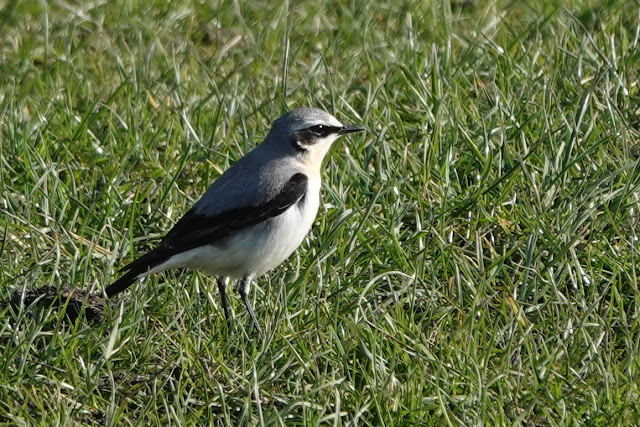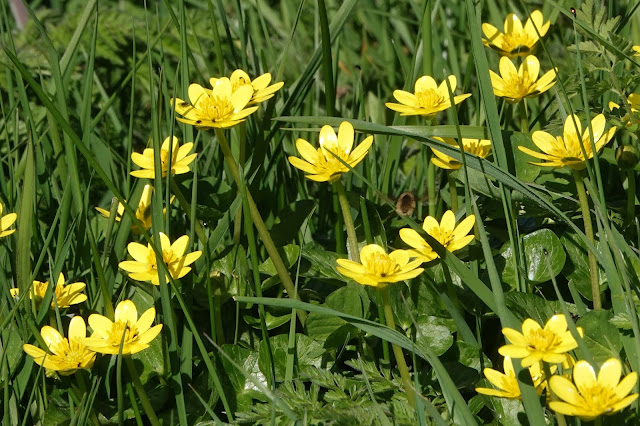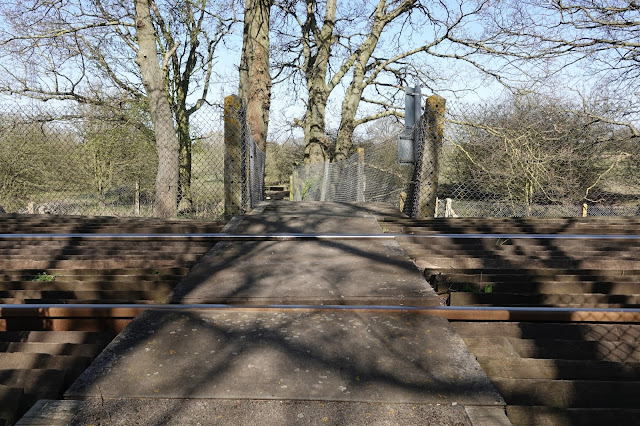It was fortuitous that my day off was forecast to be
glorious and I decided to drive to Lower Higham and access the marshes for the
first time rather than materialise in a small Devonshire seaside town overnight
as if by magic...
I followed Barry W’s advice about where to start from and
was already gobsmacked before I even left the car for the marsh meadows
alongside Canal Road felt more like a little bit of the Fens or Somerset
Levels. They were crying out for a sneaky
pair of Garganey or Black Winged Stilt or three or a whole selection of rare
skulky Herons in a few weeks time. There
were six Little Egrets, some Coots and three pairs of Egyptian Geese to be
seen.
 |
| Egyptian Geese |
One of the disadvantages of limited my car driving last year
was that although I may have discovered some amazing places on foot from home,
I only really ventured out further other than during Butterfly season. A bit like Cliffe Marshes, I could have
walked there as it is only about six miles from home but by the time a circuit
is done it becomes a very long day with a lot of road walking at either end.
Anyway, I parked up and headed along the official towpath
next to the now overgrown (and even more herony!) canal on my left and the
extensive firing range marshes on my right.
Chiffchaffs and Cetti’s Warblers were vocal and Long-tailed Tits were
collecting feathers and fluff from the Willows while out on the marsh there
were parties of Shelduck and a male Green Woodpecker was foraging for ants.
 |
Not sure what the name is for this style of laid hedge - must ask Dad
|
 |
| Green Woodpecker |
Two Kingfishers peeped a duet out of view before moving off
and Med Gulls called overhead and unsurprisingly were a constant companion for
the circular walk.
 |
There are lots of pylons
|
I got distracted by some horses in the meadow next to me as
two of them engaged in some friendly but determined sparring. Horses like this are a feature of the North
Kent Marshes with their skew and piebald coats and wild flowing manes. The play
fight ended amicably enough and both returned to grazing.
Just as I turned onto the footpath to cross to the sea wall
a man stopped and raised the red flags.
This would have put the kybosh on my loop but he said that they would
not be starting for 45 minutes and I should get to the seawall by then!
The Ranges were to the west and I could see the back of the
rifle butts like at Rainham and although I was probably a mile away, I did not
linger too long on that section. The marsh to the west is Shorne and I am
pretty sure that is the main RSPB area down here. The predator proof fence
certainly looked familiar and within it were countless Redshanks and Lapwings
and I could see several of the latter on nests.
Duck and geese were liberally scattered around but the sward was much
shorter than at Rainham and I suspect that it may be sheep grazed like the rest
of the marshes I was see throughout my walk.
 |
| Lapwing |
Just under a hundred Curlews came in off the Thames and
dropped into Higham and a flock of Wigeon and Teal did likewise into Shorne.
 |
| Curlews |
At the far end lays the ruins of Shornemead Fort which I had
previously only seen from my boat trips on the river. It only has a front now and the whole
crumbling edifice has been adorned with graffiti and street art. I was hoping
for a Black Redstart but was content with a smart singing male Greenfinch and a
party of twittery Linnets.
 |
male Greenfinch
|
I found several patches of Wall Rue growing in the shady
recesses of the fort and was intrigued by the giant Lego Blocks...
 |
Wall Rue
|
The sun was really starting to burn through now and that
meant that my inland view was somewhat stymied by the light but it did not stop
me hearing flocks of Med Gulls out over the marshes along with several singing
Cetti’s Warblers and the curious song of a Water Rail from a distant reedy
ditch.
 |
Med Gull
|
 |
| Linnets |
 |
| Med Gulls |
As usual with any walk of mine, the tide was way out and
still going but I still found Avocets, Oystercatchers, Redshank and Curlews on
the mud along with Shelduck and a few gulls.
There was nothing coming up the Thames bar a light steady stream of
Black-headed Gulls.
 |
| Curlew |
The wall here is obviously somewhat popular with the lovers
of off road motor vehicles and had been churned up on both sides and the
top. The recent windy days had dried
things out somewhat but I can only imagine how bad it was during the winter
months. It felt like there should be a
Wheatear or two to be found but when I did find one it swiftly became seven!
Five males and two females were seen focused around an area of rubble piled up
at the base of the wall. One or two were
fairly accommodating but within a few minutes the whole group had moved inland.
I saw my first at Rainham on Saturday morning as it zipped over the road so it
was a good to be able to stop and watch these dapper travellers feed up.
Two more were encountered about half a mile further up as I
scanned the marsh for interesting white egrets but I could not find one heron
of any sort.
It was still very windy and the only insects seen were
Yellow Dung flies and lots of what I am sure were Andrena flavipes flying very
low to the grass.
Skylarks were singing and I picked up a few Meadow Pipits
and two Reed Buntings as I walked east alongside Higham Bight towards Cliffe.
 |
| Oystercatchers |
 |
| Coltsfoot |
 |
Andrena flavipes
|
 |
Yellow Meadow Ant Hills
|
I scanned the Alpha Pool and found a few Great Crested
Grebes but was pleased to find a partial sum plum Black-necked too tucked down
the southern end. I have not seen this
pit from this side before and never realised that there was another one just
beyond it by the gravel works.
 |
Alpha Pit with DP World left and Thundersley off to the right above Holehaven
|
I sat on the bank and had a coffee and watched the world go
by. Four strange geese circled and
revealed themselves to be of mixed Canada and Barnacle parentage before heading
back to Cliffe and way up above in the now cloudless blue a male Marsh Harrier ‘sang’
and Skydanced for the attention of a female hunting way out over the fields. The floods here were littered with Redshanks
and Lapwings and I could hear two Little Ringed Plovers out there but could not
pick them up.
 |
Canacle Geese
|
 |
male Marsh Harrier dancing in the heavens
|
 |
Over Alpha toward Radar Pool
|
Buzzards drifted over almost continuously and spooked the
duck hiding in the deeper rills and channels and over 200 Teal rocketed into
the air with Shoveler, Gadwall, Wigeon and Mallard. There must be a Garganey out there
somewhere?!
 |
Common Buzzard
|
 |
| Lapwing |
My third Kingfisher of the day flashed across in front and I
could hear Little Grebes in the ditches and the constant calls of pearly white
Med Gulls passing overhead. Seven Little Egrets dotted the marsh with plumes wafting in the breeze.
 |
| Little Egret |
 |
| Little Egret |
 |
Med Gull
|
 |
Med Gull and Black-headed Gull - so different underneath
|
At this point I dropped down off the river wall and took the
footpath that headed for St Mary’s Church in Lower Higham. It wiggled between a
pit on the left which had surface feeding Wigeon and the marsh on the
right. The Hawthorns in between had
several singing Chiffchaffs and I could hear the delightful cascade of a Willow
Warbler and the start up song of a Blackcap.
there were a myriad of dancing small flies and quite a few more Andrena
flavipes on the Coltsfoot along with my first Peacock butterflies of the day
and a single plopping Marsh Frog.
 |
| Andrena
flavipes |
I found a fine herd of cattle (Sussex I think?) but there
were not Cattle Egrets with them but at least I know where to look now.
 |
St Mary's
|
I crossed the railway and popped out at the wooden spired
church and had an early lunch against the graveyard wall. Dark-edged Beeflies
and male Anthophora plumipes zipped between Primrose and Celandine blooms and a Goldcrest sang from the large Yew.
I had a quick look inside the fund Phytomyza ilicis on the
Holly and a pair of Mistle Thrushes collecting food as well as a splendid pair
of Pied Wagtails that were likewise foraging.
They were keeping and eye on the displaying Buzzards way up above.
 |
| Phytomyza ilicis |
 |
Mistle Thrush
|
 |
Pied Wagtails - just one of the male
|
 |
Common Buzzard
|
 |
Weathered wooden grave cross for William Wells from 1914
|
I consulted my map (yes, a real OS one) and swung a right
just past the church. The verge below the cottages was alive with insects with
Andrena flavipes all the way alond as well as several Beeflies, Honey Bees and
Buff-tailed Bumbles. One car had attracted a congregation of mostly male Musca
autumnalis and I shall predict that they will be smothering the visitors centre
when I go to work tomorrow!
 |
Nomada fabriciana - female
|
 |
| Andrena flavipes |
 |
| Andrena flavipes |
 |
Dark-edged Beefly
|
 |
| Musca
autumnalis |
The last cottage was almost in the marsh and with a
Phragmites and Reedmace bed almost in the garden. Great Willowherb was just shooting and there
was Celery Leaved Buttercup a little further out.
 |
| Celery Leaved Buttercup |
The footpath from here on was somewhat damp – in fact it was
under water and mud in places but I pressed on through. Great Spotted Woodpecker, Stock Dove, Grey Wagtail,
Jay and Coal Tit were all new for the day list.
It crossed back over the railway and I had to veer off course to get
around the water but once regained it dried out and climbed slightly which
provided me with some more insect opportunities in the Nettled edges with Eudasyphora
cyanella seen once again along with Eristalis tenax and pertinax and Meliscaeva
auricollis hoverflies. There were several mining bees including Andrena flavipes
again but I am awaiting help on the other species I saw.
 |
| Chiffchaff |
 |
| Eudasyphora
cyanella |
 |
| Eristalis pertinax |
 |
| Eristalis pertinax |
 |
Andrena praecox
|
 |
| Andrena praecox |
Brimstone, Peacock, Small Tortoiseshell and Comma were all
seen but seldom landed and a Common Lizard was basking on a small footbridge.
 |
Common Whitlowgrass
|
 |
Seven Spot Ladybird
|
I had reached Canal Road once more and was just a few
hundred yards from the car with damp feet but a big smile after a pleasing
first circumnavigation. I suspect that I
can park by the church and just head out to that section of the marsh which may
well become one of my new ‘got a spare hour or two’ spots for the spring.
I was back home for a lunchtime (and resisted a second one)
and with the sun still shining and temperature not too far off twenty I headed
up the garden for a while to see what I could find.
Male Anthophora plumipes were careening around all over the place
and seemed to be heading back over the back fence so I suspect a lawn over
there has the colony and it took and age to get one to land long enough for me
to get a shot or two!
 |
| Anthophora plumipes |
Beeflies attended the Red Dead Nettle and there were several
Andrenas about including A.flavipes and what I think are A.trimmerana (brown
and furry) but it was also good to see two female A.fulva in their vibrant
almost orange livery.
 |
Dark-edged Beefly
|
 |
| Andrena nigroaenea |
 |
| Andrena nigroaenea |
 |
| Andrena nigroaenea |
 |
Andrena bicolor
|
 |
The first Marsh Marigold flower
|
 |
Spurge sp
|
 |
| Spurge sp |
Eristalis pertinax and several Meliscaeva auricollis were
seen with the latter already holding ‘hover territories’ and Comma and Peacock
ventured down briefly. It really felt
good to be able to sit and watch the comings and goings in the newest sections
of my garden and all the hard work seems to be paying off already.
 |
| Meliscaeva auricollis |
 |
| Meliscaeva auricollis |
 |
Not sure yet...sending it to Phil!
|
 |
Calliphora sp
|
 |
| Calliphora sp |
 |
Comma - looks like woken up rather than fresh and new!
|
 |
| Peacock |
On top of that the frogspawn seems to be developing nicely
and a male Smooth Newt was my first this year while my cats found a fine plump
Slow-worm in the Catio which I moved up the garden and away from the other
felines that like to call my garden home.
 |
Grazing Ramshorns
|
 |
| Slow-worm |
 |
and three of my garden cats...
|
 |
And my Jasper - Prince of Darkness watching proceedings...
|
Dock Leatherbugs and now almost green Green Shieldbugs were
sunning on the Ivy with Seven Spot Ladybirds and the big Queen Buff-tailed
Bumble was back on my Fritillaries.
 |
| Dock Leatherbug |
 |
| Green Shieldbugs |
I am quite looking forward to this spring...






































































































































Your nomad is fabriciana, mystery Andrena is almost certainly A. praecox, the furry Andrena is nigroaenea rather than trimmerana and the chunky flavipes is not flavipes and probably A. bimaculata.
ReplyDeleteThank you ever so much mystery person!
DeleteGreat blog Howard, really enjoyed a good read, can't wait to get back to Blightie
ReplyDeleteThanks Nick
ReplyDelete